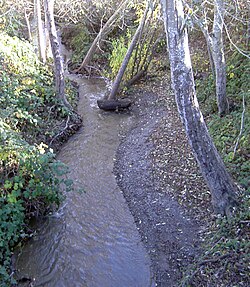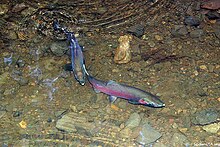| Salmon Creek | |
|---|---|
 Salmon Creek near Freestone, California Salmon Creek near Freestone, California | |
| Location | |
| Country | United States |
| State | California |
| Region | Sonoma County |
| Cities | Occidental, Freestone, Bodega, Salmon Creek |
| Physical characteristics | |
| Source | |
| • location | 2 mi (3 km) west of Occidental, California |
| • coordinates | 38°23′34″N 122°58′22″W / 38.39278°N 122.97278°W / 38.39278; -122.97278 |
| • elevation | 800 ft (240 m) |
| Mouth | Pacific Ocean |
| • location | west of Salmon Creek, California |
| • coordinates | 38°21′18″N 123°4′4″W / 38.35500°N 123.06778°W / 38.35500; -123.06778 |
| • elevation | 0 ft (0 m) |
| Basin features | |
| Tributaries | |
| • right | Nolan Creek, Tannery Creek, Fay Creek, Coleman Valley Creek, Finley Creek |
Salmon Creek is an 18.3-mile-long (29.5 km) stream in western Sonoma County, California that springs from coastal hills west of the town of Occidental and empties into the Pacific Ocean north of Bodega Head.
Course
Salmon Creek originates about 2 miles (3 km) west of the town of Occidental near the junction of Joy Road and Bittner Road. It parallels Bittner Road eastward, passing just south of Occidental, where it turns right and follows Bohemian Highway to the town of Freestone. From there, it curves south and then west, passing Watson School historic park as it parallels Bodega Highway to a confluence with Nolan Creek just east of the town of Bodega. It flows through Bodega, then follows Salmon Creek Road westward into a narrow canyon, where it is joined by Tannery Creek, Fay Creek, Coleman Valley Creek, and Finley Creek. Salmon Creek emerges from the canyon between Irish Hill and Coleman Hill and crosses State Route 1 at milepost 12.49, entering Sonoma Coast State Beach south of the ranger station. It parallels Bean Avenue to Salmon Creek Beach, which it bisects as it enters the Pacific Ocean.
History
When European explorers first reached Salmon Creek, they found it inhabited by Coast Miwok people. Six Coast Miwok villages near the creek have been authenticated: Pulya-lakum, near the mouth of the creek, Kennekono and Suwutenne near the present-day town of Bodega, and three near the present day town of Freestone: Oye-yomi, Pakahuwe, and Patawa-yomi.
In 1843-44, most of the Salmon Creek watershed was included in the 35,000-acre (140 km) Rancho Bodega land grant awarded to Captain Stephen Smith.
In 1873, the North Pacific Coast Railroad built a narrow-gauge line along the stretch of Salmon Creek between Freestone and Occidental as part of the route from Sausalito to Cazadero.
Ecology

As of 2000, Salmon Creek and its five named tributaries all supported steelhead trout (Oncorhyncus mykiss). Salmon Creek also harbored California freshwater shrimp (Syncaris pacifica), and coho salmon (Oncorhyncus kisutch) were known to inhabit both Salmon Creek and Tannery Creek. By 2006, however, the salmon run had ceased. On July 2, 2010 the Salmon Creek Water Conservation Plan was released with important recommendations for restoring dry season instream flows, which have been exacerbated primarily by man-made water diversions. The Plan included such innovative solutions such as rooftop water harvesting and re-introduction of Golden Beaver. The historic presence of beaver was evident in the first Russian-American Company voyage by Ivan Kuskov who sailed into Bodega Bay in 1809 on the Kodiak and returned to Novo Arkhangelsk, Alaska (Sitka), with beaver skins and over 2,000 sea otter pelts. French naval captain Cyrille Laplace visited the Russian farms with the Aleksandr Rotchev, the last manager of Fort Ross, in 1839. After spending time at the Chernykh farm (near Graton probably on Purrington Creek) they rode to the Kirill Timofeevich Khlebnikov farm (near Bodega Corners) on Salmon Creek and wrote, "we had stopped a moment by a little river on the banks of which my traveling companion pointed out to me the former habitations of beaver, probably destroyed by the Indians in order to catch the rich prize that lay within." In 2009 and 2010 the California Department of Fish and Game have re-introduced coho salmon into Salmon Creek.
It is also the only extant location of the nearly extinct Baker's larkspur.
Bridges

At least seven bridges span Salmon Creek. The newest and longest of these is the State Route 1 bridge, which is 200 feet (61 m) long and was built in 1983. Freestone Flat Road crosses on a steel truss 103 feet (31 m) long which was built in 1955, making it the oldest of the seven. Bodega Highway crosses in two places: 0.9 miles (1.4 km) from State Route 1 on a bridge 92 feet (28 m) long built in 1962 and at Valley Ford-Freestone Road on a 76 ft (23 m) bridge built in 1968. Salmon Creek Road spans the creek on a 78 ft (24 m) bridge dating from 1958, Bohemian Highway crosses on a 70 ft (21 m) bridge from 1971, and Scouts Camp Road crosses on a 57 ft (17 m) structure from 1960.
Further reading
- DFG California Department of Fish and Game 1964. Salmon Creek Stream Survey, April 29, 1964 by Weldon Jones
- DFG California Department of Fish and Game 2004. Salmon Creek Stream Survey, September 2004
- USGS BODEGA HEAD Quad, California, Topographic map – 1972
- USGS VALLEY FORD Quad, California, Topographic map – 2009
- USGS CAMP MEEKER Quad, California, Topographic map – 2009
See also
References
- ^ U.S. Geological Survey Geographic Names Information System: Salmon Creek
- U.S. Geological Survey. National Hydrography Dataset high-resolution flowline data. The National Map, accessed March 9, 2011
- "Miwok Indian Tribe". Access Genealogy. Retrieved 2007-12-04.
- ^ Prunuske Chatham, Inc. (2006). "Salmon Creek Estuary: Study Results and Enhancement Recommendations" (PDF). Retrieved 2010-07-03.
- Cox, Bill (2000). "Major Streams in Sonoma County" (PDF). Retrieved 2007-12-04.
- Prunuske Chatham, Inc., Virginia Porter Consulting and Occidental Arts and Ecology Center’s WATER Institute. Salmon Creek Water Conservation Plan (PDF) (Report). Salmon Creek Watershed Council. Retrieved 2010-07-03.
{{cite report}}: CS1 maint: multiple names: authors list (link) - Thompson, R. A. (1896). The Russian Settlement in California Known as Fort Ross, Founded 1812...Abandoned 1841: Why They Came and Why They Left. Santa Rosa, California: Sonoma Democrat Publishing Company. p. 3. ISBN 0-559-89342-6. Retrieved Jan 9, 2010.
- Glenn Farris (2006). Visit of Cyrille Pierre-Theodore Laplace to Fort Ross and Bodega Bay in August 1839. Fort Ross Interpretive Association. p. 64.
- "Your Salmon Creek - A Video on the Reintroduction of Coho Salmon into a Sonoma County Coastal Watershed". Occidental Arts and Ecology WATER Institute. Archived from the original on 2021-12-12. Retrieved 2010-07-04.
- "Delphinium bakeri".
- "National Bridge Inventory Database".